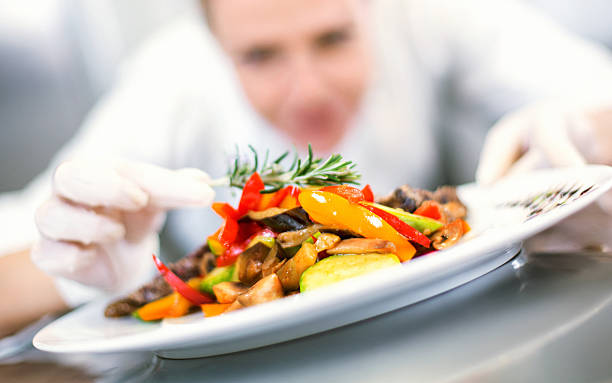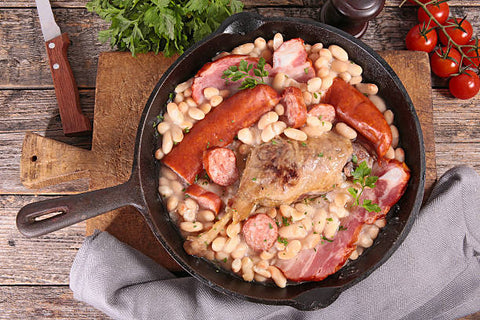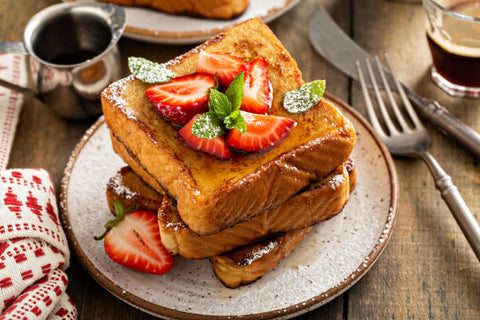French cuisine is known for its elegance and flavor, but how do you replicate these flavors at home? With these famous French cuisines, complete with their recipes, you can bring that special something to your home. Simple combinations of rich, natural tastes are used to create remarkable, world-famous dishes in French cuisine. Indeed, French food is so famous throughout the globe that it was mentioned on the intangible cultural heritage list of UNESCO in 2010.
People are frequently introduced to French cuisine through wine and cheese. There are numerous detectable combinations to pick from, from Burgundy and brie and to Chardonnay and camembert. But, beyond the cheeseboard, there's an entire world of French cuisine to explore. We've compiled a list of the famous French recipes you should try at home, to assist you in bringing the magic of French cooking into your home. Wishing you the best of luck with your meal!
Famous French Foods–with Recipes
- Coq au vin
This classic French recipe became famous thanks to Julia Child, and it became one of her main dishes. This dish calls for braising chicken with mushrooms, wine, bacon (lardons) or salty pork, garlic, onions, and sometimes a drop of brandy. Even though the name means "rooster in wine" and for harder birds, the braising process is ideal, capon or chicken are usually used in the recipe. Although there are regional versions of the dinner that use local wines around France, the wine is normally Burgundy. Even there is a coq au Champagne, believe it or not.
Recipe
- With a dash of brandy, chicken is slowly cooked in red wine in a traditional French stew, the result is a luxuriously rich sauce with yummy meat, mushrooms on the side, crisp bacon bits on top, and pearl onions that have been burnished to a lustrous sheen.
- Tradition calls for a whole chicken that has been sliced up but utilizing only the black flesh results in a more flavorful dish that does not run the risk of the white meat overcooking and becoming dry.
- You can substitute a full cut-up bird for the breasts by adding them to the boiling water during the last half hour of cooking.
- Croutons are optional, but they do lend a deliciously buttery crunch to the vegetables and simmering, soft beef.
- Cassoulet
A hearty stew made with pork and white beans is known as cassoulet. The dish is traditionally made with pork or duck, but it can also be made with goose, sausages, mutton, or whatever other ingredients the cook has on hand. In Toulouse, Carcassonne, and Castelnaudary, this southern French peasant dish is well-known. The dish's name comes from the traditional baking pot (cassole) in which it is prepared. Many French homes have this pot, demonstrating the popularity of this hearty, rich dish, which is ideal for the colder months.
Recipe
- Soaking the beans overnight in salted water keeps them soft while cooking.
- When chicken is used in place of duck, it absorbs a lot of the flavor from the cured meats, resulting in a dish that is meltingly delicate and beefy.
- Adding gelatin to the cooking liquid helps the casserole develop a nicer crust as it bakes.
- Bœuf bourguignon
Beef bourguignon is one of the most traditional French dishes. The cuisine comes from the same part of France as coq au vin, Burgundy, and the two dishes have certain similarities. Boeuf bourguignon is a red wine-braised beef stew with seasoned vegetables such as pearl onions and mushrooms in a beef broth. This recipe, which originated as a peasant meal, has now become a staple in French restaurants worldwide. Tenderizing cheap slices of beef in wine for two days to bring out the flavors is common practice, though there are several workarounds.
Recipe
- Combine 1.6kg of sliced braising steak, a small bunch of thyme, 3 bay leaves, pepper,
and 2 bottles of red wine in a large mixing basin, cover, and refrigerate overnight.
- Preheat the oven to 200 oC/gas 6/180oC fan.
- “Drain the marinated meat through a sieve over another large bowl, reserving the wine.”
- “Heat 1 tablespoon of oil in a frying pan, then brown the meat in stages, transferring to a dish once it's finished.”
- After all of the meat has been cooked, pour a small quantity of wine into the empty frying pan and allow it to bubble to remove caramelized remnants.
- In a large casserole, sauté 6 standard carrots, sliced into big pieces, and two onions (finely chopped) in 1 tablespoon oil until they begin to brown.
- For 1 minute, stir it in plain flour (3 tbsp), and then add 1 tbsp tomato purée.
- Add the steak, as well as any juices from the frying pan, the remaining wine, and the herbs.
- After seasoning with salt and pepper, reduce to low heat. Cover after giving everything a vigorous swirl.
- Preheat the oven to 200°F and bake the beef for 2 hours, or until it is completely tender. Cool. It will keep for up to three months in the freezer.
- If frozen, defrost overnight in the refrigerator before serving, and then reheat over low heat until warm.
- In a second frying pan, melt a little knob of butter and add peeled pearl onions or small shallots (500g) and bacon lardons (300g).
- Cook for 10 minutes, stirring periodically, or until the onions have softened with turned color, and the bacon is crisp.
- Fry for another 5 minutes with 400g halved mushrooms, and then add everything into the stew and cook for another 10 minutes.
- Serve with chopped parsley as a garnish.
- Soufflé au chocolat
The light and fluffy dessert is known as soufflé is called after the French word 'to blow.' Since its invention in the early 1800s, the dish has been included on dessert menus throughout the world. For a wonderful surprise, the creamy chocolate seeps out of the crisp chocolatey shell. But it doesn't have to be sweet. If you want something a little saltier, cheese soufflés are just as excellent.
Recipe
- Preheat the oven to 180 o
- Butter a tall-sided baking dish with a light coating of butter.
- Spead sugar on the surface and wipe away extra sugar with a paper towel. Place the dish on a rimmed baking sheet.
- “Combine chocolate, vanilla, and 1/4 cup water in a large heatproof plate put over a pot
of simmering water.”
- “Stir for 10 minutes, or until all of the chocolate has melted and the mixture is smooth.”
- “Remove from the heat and leave aside for 20 minutes to cool to room temperature.”
- “In a separate bowl, whisk together the egg yolks and the cooled chocolate mixture until
completely blended. Set aside the souffle base.”
- “Whisk egg whites and cream of tartar together in a large mixing basin for 2 minutes
on medium-high speed, or until soft peaks form.
- “Gradually add the sugar and continue to beat for another 5 minutes, or until stiff, glossy
peaks form (do not overbeat).
- “Fold the egg white mixture into the souffle foundation in two batches: Cut down the
center of the bowl with a rubber spatula and lift some of the bases from the bottom.”
- “Continue to chop down and draw up the base while tilting the bowl until it is barely
mixed.”
- “Transfer the batter to the baking dish, spreading it out and being careful not to get batter
on the dish's top edge.”
- “Preheat the oven to 350 degrees Fahrenheit and bake for 30–35 minutes or until puffy
and firm (For the first 25 minutes of baking, do not open the oven).”
- Serve right away.

- Flamiche
Flamiche is cuisine from northern France that means cake in Dutch. It is topped with a puff pastry crust and is similar to quiche in that it is filled with cheese and veggies. Leeks and cream are the typical fillings, but there are many variants. Flamiche is also available without the top crust in a pizza-style variant. A southern French variant on this dish is to serve it on a thin pissaladière with anchovies, olives, and onions.
Recipe
- Preheat the oven to 200 degrees Celsius for this snack.
- After thinly slicing the leeks on a chopping board, place them in a basin.
- Melt the butter in a medium-sized saucepan.
- Swirl the thinly sliced leeks into the heated butter to fully integrate them.
- Allow for a few minutes of cooking time until they are soft. Remove it from the flame once it's finished.
- In a mixing bowl, crack the eggs open and whisk them together.
- Season the milk in the same basin as the eggs with black pepper powder and salt.
- In a separate pot, combine the fried leeks.
- Place the pie crust on top of the egg-leek mixture in a baking dish. It should be dispersed
- “Preheat the oven to 350°F and bake the Flamiche for 10-15 minutes in the baking dish.”
- Reduce the heat to 170 degrees Celsius and continue baking until the top is gently
browned.
- When it's completed baking, take it out of the oven and lay it on a serving tray to cool.
- Slice it up while it's still warm to enjoy.
- Salade Niçoise
In Provence, Salade Niçoise is a typical French salad made with a variety of vegetables and herbs. It's usually served as a side dish, but it's also good as a light supper. Fresh tomatoes, lettuce, boiled eggs, green beans, canned or fresh tuna, anchovies, and Nicoise Cailletier olives make up this salad. There are, however, a plethora of options to consider. If you're having trouble coming up with the perfect summer dinner, try Salade Niçoise.
Making the Niçoise Salad Ahead of Time
- Although these components can be prepared ahead of time, the salad should be assembled only before serving. To begin, bring all cold materials to room temperature.
- Make the vinaigrette ahead of time and chill it.
- Marinate the onions in the refrigerator for up to a day.
- Hard boil the eggs the day before and store them in the refrigerator.
- Just before serving, peel, and slice.
- Begin prepping the potatoes a day in advance.
- “Refrigerate in a tightly closed container in the refrigerator.”
- Get the green beans ready ahead of time.”
- “Refrigerate in a tightly closed container in the refrigerator.”
- “Tear the lettuce and cut the tomatoes after removing the cores.”
- Ratatouille
Ratatouille is a famous French dish as well as a delightful animated film about a good rat. The vegetables are shallow-fried before being arranged in a casserole dish and baked in this Provence-inspired recipe. For years, French cooks have debated whether the veggies should be cooked first or not, but the results are delicious either way. This traditional peasant dish goes well with crusty bread and red wine as a side dish, appetizer, or main course. Pipérade is a Basque meal that consists of a stewed vegetable mixture with ham and eggs.
Recipe
- Preheat the oven to 190 o
- Cut the tomatoes, eggplant, squash, and zucchini into 1/16-inch rounds and put them
aside.
- “In an oven-safe pan (12-inch), heat the olive oil over medium-high heat to prepare the
sauce.”
- “Cook, stirring occasionally, for about 10 minutes, or until the onion, garlic, and bell
peppers have softened.”
- Add the smashed tomatoes after seasoning with pepper and salt.
- “In a large mixing basin, mix all of the ingredients and stir until well combined.”
- Remove the pan from the stove and add the basil.
- Stir once more, and then use a spatula to smooth up the surface of the sauce.
- To assemble, arrange the sliced veggies on top of the sauce in an alternate pattern, starting at the pan's outer edge and working your way in toward the middle.
- To taste, season with salt and pepper.
- For herb seasoning, combine the basil, parsley, garlic, thyme, pepper, olive oil, and salt in a small pot. Season the vegetables with herb seasoning.
- Bake for 40 minutes with the pan covered with foil. Remove the lid and continue baking for about 20 minutes, or until the softening of vegetables.
- Serve as a side dish or main course right away.
- Cover and microwave to preferred temperature the next day or reheat in a 180°C (350°F) oven for 15 minutes.
Enjoy!




